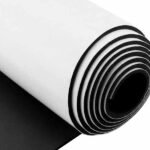When it comes to materials that offer both flexibility and durability, few are as versatile as neoprene. But one of the most asked questions about this material is, does neoprene keep you warm? Known for its application in wetsuits and bags, neoprene is a popular choice for many products designed to endure cold temperatures. In this post, we will explore whether neoprene can really keep you warm and how it compares to other materials when it comes to thermal insulation.
Yes, neoprene can keep you warm. Its unique insulating properties trap heat close to the body, making it an ideal material for products used in cold and extreme weather.
Transition paragraph:
Before answering if neoprene can truly keep you warm, let’s first understand what neoprene is and how its insulating properties work. This will help us appreciate its advantages in thermal protection and why it’s used in so many weather-resistant products.
What is Neoprene?
Neoprene, also known as polychloroprene, is a type of synthetic rubber made from the polymerization of chloroprene. This material was first invented in the 1930s and quickly became popular in the manufacturing of wetsuits, gloves, and other protective gear because of its flexibility, durability, and resistance to various environmental elements. Neoprene is highly valued for its ability to retain its properties in both cold and hot conditions, making it a prime material for products used in outdoor and sports-related activities.
Neoprene is a synthetic rubber with a unique structure that provides durability, flexibility, and thermal insulation. It is commonly used in items like wetsuits, bags, and accessories.
How Does Neoprene Insulate?
One of the most remarkable features of neoprene is its ability to act as an insulator. Neoprene insulation works by trapping tiny air pockets within its structure. These air pockets act as a barrier, preventing heat from escaping and cold from penetrating the material. This feature makes neoprene an excellent choice for products that need to maintain body heat, such as wetsuits, jackets, and insulated bags.
The material is made up of a closed-cell structure, meaning that the cells are tightly packed and do not allow the free passage of air. This property helps maintain warmth by minimizing the transfer of heat between your body and the outside environment.
Neoprene insulates by trapping air in its closed-cell structure, effectively keeping body heat in and cold air out.
Dive Deeper:
Neoprene’s insulation properties are largely due to its closed-cell foam structure. When used in wetsuits, for example, the neoprene material traps a thin layer of water between the suit and the skin. This water gradually warms up with your body temperature, creating a thermal layer that keeps the cold water away from your body. Similarly, neoprene is used in bags and sleeves to help insulate the contents, keeping drinks or electronics at a stable temperature, even in colder environments.
Another key element of neoprene’s insulating properties is its elasticity. The material is highly stretchable, which allows it to fit snugly against the skin or surface, minimizing the amount of air that can pass between the material and the body. This is crucial for ensuring the thermal efficiency of the product, as gaps can allow cold air to penetrate and reduce insulation performance.
Is Neoprene Good for Winter?
Yes, neoprene is an excellent material for winter. Whether you are talking about neoprene gloves, jackets, or bags, this material can provide the warmth and protection needed during cold months. Since neoprene helps trap heat and provides excellent insulation against the cold, it is used in a variety of winter products, including gloves for skiing, winter jackets, and even footwear.
Neoprene’s flexibility and resistance to water make it an ideal choice for outdoor activities in cold and wet conditions. When used for winter clothing, neoprene helps keep your body warm while still allowing for comfort and movement.
Neoprene is great for winter use because of its ability to trap heat, keep water out, and protect against cold winds.
Dive Deeper:
For winter use, neoprene products are often designed with extra thickness, especially in gloves, boots, and wetsuits. The thicker the neoprene, the better the insulation. In fact, many high-performance winter wetsuits use neoprene that’s specially engineered for extreme cold conditions, keeping divers, surfers, and skiers warm even in freezing waters. Neoprene’s durability also ensures that it can handle harsh weather without compromising performance.
Additionally, neoprene’s water resistance is a critical factor for winter use. Since it prevents water from soaking through, it keeps users dry and warm, even in snow or rain. This is why neoprene is often used in snow gear, such as ski boots and snow gloves.
Does Neoprene Keep Heat In?
Yes, neoprene is designed to keep heat in. As mentioned earlier, the air pockets trapped in neoprene act as insulation, preventing heat from escaping. This makes it effective in keeping the warmth close to your body, particularly in cold conditions.
In products like insulated bags, neoprene is used to maintain the temperature of food or beverages, whether hot or cold. For instance, neoprene koozies are designed to keep your drink cool in the summer and warm in the winter by blocking temperature fluctuations from the environment.
Neoprene helps keep heat in by trapping air inside its closed-cell structure, making it a great material for warmth retention in various products.
Dive Deeper:
The heat retention ability of neoprene is what makes it such a popular choice for a range of products. For example, neoprene laptop sleeves protect your electronics from temperature extremes, keeping your device from overheating or getting too cold. Similarly, neoprene travel bags can maintain the warmth of hot food or beverages, offering convenience while on the go.
Its thermal insulation properties make neoprene particularly popular in medical and health-related products, such as knee braces and wrist supports, where warmth is needed to help reduce muscle stiffness and improve circulation.
Is Neoprene Hot to Wear?
While neoprene is effective at keeping warmth in, it is not necessarily hot to wear in all circumstances. For example, in products like wetsuits, neoprene is designed to retain just enough heat to keep you comfortable without causing overheating. Its breathable nature helps regulate temperature, so you won’t get too hot while wearing it.
However, in highly active scenarios or warmer weather, neoprene may feel too warm. It’s important to choose the right thickness and type of neoprene depending on the activity and climate conditions. Thicker neoprene provides more insulation, which is ideal for colder environments, while thinner neoprene may be more suitable for warmer conditions.
Neoprene isn’t inherently hot to wear but can feel warm depending on thickness and usage. Its breathability helps keep temperatures regulated.
Does Neoprene Keep You Warm in Extreme Conditions?
Yes, neoprene is highly effective in extreme conditions, especially when it comes to retaining body heat in cold and wet environments. Neoprene wetsuits are used by divers and surfers in freezing cold waters, keeping them warm despite prolonged exposure to low temperatures. Similarly, neoprene is used in cold-weather gloves, boots, and outerwear, all designed to withstand extreme temperatures while keeping the wearer insulated from the cold.
Neoprene is highly effective in extreme cold and wet conditions, making it the go-to material for outdoor gear in harsh climates.
Dive Deeper:
For extreme conditions, neoprene products often include additional features, such as sealed seams, to prevent water from entering and affecting thermal performance. Custom neoprene suits are often used by athletes in extreme sports, where body temperature regulation is crucial to performance and safety. The insulation power of neoprene remains consistent even in wet conditions, which is a significant advantage over other materials.
Conclusion
In summary, neoprene is an excellent material for maintaining warmth, whether in cold, wet, or extreme conditions. Its unique closed-cell structure traps air to keep body heat in, and its flexibility and durability make it ideal for winter products, wetsuits, bags, and other accessories. While it’s not always hot to wear, neoprene’s ability to regulate temperature and provide insulation makes it an indispensable material for many industries. If you’re considering a product that requires warmth retention, neoprene is certainly a great choice.
If you’re looking to create custom neoprene products that offer warmth and comfort, feel free to reach out to us at Szoneier. We specialize in customizable neoprene bags, gloves, wetsuits, and more. Get in touch today to discuss your project and explore how our high-quality neoprene can meet your needs.











